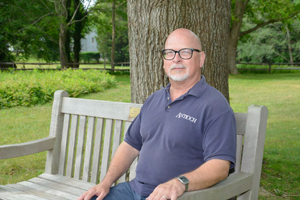
Image of Charlie Doering as Principal Lecturer of the 2015 Summer Study Program in Geophysical Fluid Dynamics at Woods Hole Oceanographic Institution: ‘Stochastic Processes in Atmospheric and Oceanic Dynamics.’ Used with permission from WHOI.
Charles Rogers Doering, Nicholas D. Kazarinoff Collegiate Professor of Complex Systems, Mathematics, and Physics at the University of Michigan, and Associate Editor of Journal of Fluid Mechanics Perspectives (July 2015–June 2018), passed away on 15 May 2021, surrounded by his loving family, after a challenging year battling oesophageal cancer with his customary indomitable spirit.
Charlie was born in Philadelphia on 7 January 1956 and grew up in Norman, Oklahoma, Fairfax, Virginia, Annapolis, Maryland and Schenectady, New York. He attended Antioch College in Yellow Springs, Ohio, graduating with a BS in Mathematics and Physics in 1977. He continued his academic studies in Physics at the University of Cincinnati, where he received his MS in 1978. He then moved to the San Francisco Bay Area, first to play music exclusively, and then to work in Silicon Valley, though he never fully put his guitar down, nor stopped loving The Grateful Dead.
Academia ultimately called him back to the University of Texas at Austin, where he completed his PhD in Mathematical Physics in 1985 under the guidance of Cécile DeWitt-Morette. His thesis was titled ‘Functional stochastic differential equations: mathematical theory of nonlinear parabolic systems with applications in field theory and statistical mechanics.’ He then spent two years (1986–1987) as a Director's Postdoctoral Fellow at the Center for Nonlinear Studies, (CNLS) Los Alamos National Laboratory, where, fortunately for the field of fluid mechanics research, he first became interested in rigorous properties of solutions to the Navier–Stokes equations. In 1987, he took up a faculty position at Clarkson University, Potsdam, New York, rising to Professor of Physics. He returned as Deputy Director of CNLS in 1994, before joining the faculty of the University of Michigan in 1996, where he eventually became the Nicholas D. Kazarinoff Collegiate Professor of Complex Systems, Mathematics and Physics and the Director of the Center for the Study of Complex Systems, an optimal venue for him to pursue and champion the multidisciplinary research culture so close to his heart.
Charlie had a huge range of research interests and achievements, stretching from functional analysis, statistical mechanics and stochastic dynamical systems all the way through to a vast array of partial differential equations arising from a myriad of problems in biology, chemistry, and physics. In fluid mechanics, he was a leader in bringing the tools of ‘applied analysis’ to bear on key problems within fluid mechanics. He made major contributions to the still open problem of the well-posedness of the Navier–Stokes equations. He played a central role in reinvigorating and popularising the approach of identifying rigorous mathematical bounds on key flow quantities of interest, such as the dissipation rate within wall-bounded shear flows, and the heat flux in Rayleigh–Bénard convection. Using sophisticated analysis of the underlying properties of solutions of the governing partial differential equations, the ‘background method’, which he co-developed, has led to major breakthroughs in the understanding of what is actually possible in turbulent flows. More recently, Charlie was deeply involved in using a wide range of different techniques to explore and determine the very accessibility of different conjectured flow regimes in thermal convection, which he, quite rightly, argued is among the most important open problems in physics. The ease with which he deployed those techniques, ranging from ‘abstract’ functional and probabilistic analysis, through ‘applied’ derivation of exact solutions and asymptotic approximations, to careful ‘computational’ numerical simulation was inspiring to his many collaborators.
Through his career, Charlie received many honours including the Presidential Young Investigator Award, 1989–1994; Fulbright Scholarships in 1995 and 2001; the Hulmboldt Research Award in 2003; and Fellowships of the American Physical Society in 2001, the Society for Industrial and Applied Mathematics in 2011, the Simons Foundation in Theoretical Physics in 2014 and in Mathematics in 2021, as well as a Guggenheim Fellowship in Applied Mathematics in 2016.
Nevertheless, he always wore his scholarship lightly, with great good humour and enthusiasm. At Michigan, and indeed across the midwest through well-timed seminar invitations, he gained well-deserved fame as a startlingly colour-coordinated superfan of the Michigan Wolverines football team. He was a valued participant, and frequent organiser, of workshops, conferences and schools of all seasons. He had a genius for bringing diverse communities together to be united in their love for science and mathematics, and he often catalysed lasting and fruitful interactions. He was a caring and committed mentor of students and early career researchers, and devoted vast amounts of his time to supporting the careers of others: his capacity for letter writing for prizes and fellowships, for faculty positions, for tenure cases and prizes and fellowships again was legendary. He was a superb and memorable lecturer. Whether explaining the Fokker-Planck equation or the force play at second base, his audience was always educated and entertained in equal measure. Summering on Cape Cod, he inspired future generations of fluid dynamicists by his approach to research, to life, and to softball at the Summer Study Program for Geophysical Fluid Dynamics at Woods Hole Oceanographic Institution.
He will be greatly missed by his academic friends across the world, and leaves a huge hole in the real centre of his world, his family: his loving wife of 35 years, Paula; his children Adrienne, Emily and Evan; his sisters Elizabeth and Elaine; and three grandchildren, Sophia, Vivian, and Charles Alexander, known as ‘Arlo.’




